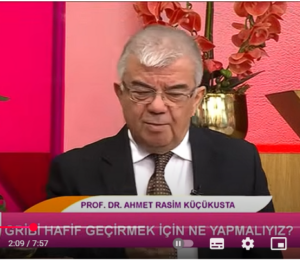TIP YAZILARI
- AĞIZ VE DİŞ SAĞLIĞI
- DİŞ MACUNLARININ ÇOĞUNDA AĞIR METALLER BULUNDU
- İÇME SUYUNDAKİ YÜKSEK FLORÜR ÇOCUKLARIN ZEKÂSINI DÜŞÜRÜYOR
- GECE DİŞ FIRÇALAMAK KALP DAMAR HASTALIKLARI RİSKİNİ AZALTIYOR
- DİŞ KAYBI BİLİŞSEL BOZUKLUK VE BUNAMA RİSKİNİ ARTIRIYOR
- DİŞETİ HASTALIKLARI AĞIR KOVİD’ E YOL AÇIYOR
- BAL DİŞ ÇÜRÜKLERİNİ ÖNLEYEBİLİR
- DİŞ HEKİMLERİ DİŞ MACUNU REKLÂMINA ALET EDİLMEMELİDİR
- DİŞLERİ FIRÇALAMAK ÇÜRÜKLERİ ÖNLEMİYOR
- GAZETECİLER ERKEK ÇORABI GİBİDİR, SAĞLARI SOLLARI BELLİ OLMAZ
- FIRÇALAMAYA EVET MACUNA HAYIR
- » Kategorinin tüm yazılarını göster
- AKCİĞER KANSERİ
- MISIRÖZÜ YAĞI VE MISIR ŞURUBU KANSERİ AZDIRIYOR, ERKEN ÖLÜME SEBEP OLUYOR
- YAPAY ZEKÂ TOMOGRAFİLERİ RADYOLOGLARDAN DAHA İYİ DEĞERLENDİRİYOR
- AKCİĞER KANSERİ GENÇ KADINLARDA ERKEKLERE GÖRE DAHA FAZLA GÖRÜLÜYOR
- YÜKSEK DOZ B VİTAMİNLERİ AKCİĞER KANSERİ RİSKİNİ ARTIRIYOR
- BİRÇOK KİŞİ AKCİĞER KANSERİ TARAMALARINDAN ZARAR GÖRÜYOR
- AKCİĞER KANSERİ METASTAZLARINDA BEYİNE IŞIN TEDAVİSİNİN FAYDASI YOK
- GLİSEMİK İNDEKSİ YÜKSEK GIDALAR AKCİĞER KANSERİ RİSKİNİ DE ARTIRIYOR
- PROSTAT KANSERİNDE IŞIN TEDAVİSİ YENİ KANSER RİSKİNİ ARTIRIYOR
- TİROİT KANSERLERİ NEDEN ARTIYOR?
- NEFES SICAKLIĞINDAN AKCİĞER KANSERİ TEŞHİS EDİLEBİLİR Mİ?
- » Kategorinin tüm yazılarını göster
- ALERJİ
- BURNUNUZU AMELİYATHANEYE SOKMAYIN, SAKIN HA!
- ALFA-GAL SENDROMU
- MİDE İLAÇLARI ALERJİ RİSKİNİ DE ARTIRIYOR
- ALERJİSİ OLANA SAÇ UYARISI
- ÇOCUĞUN YERE DÜŞEN EMZİĞİNİ AĞIZDA TEMİZLEMEK ALERJİYİ ÖNLÜYOR
- YENİ BİR ALERJİK HASTALIK: EOZİNOFİLİK ÖZOFAJİT
- OTİSTİK ÇOCUKLARDA GIDA ALERJİSİ DAHA SIK GÖRÜLÜYOR
- EGZAMADA PAHALI BANYO NEMLENDİRİCİLERİN BİR FAYDASI YOK
- DERİDEKİ DOST BAKTERİLER EGZAMAYI İYİLEŞTİRİYOR
- TAHTAKURUSU OLAN EVLERİN TOZLARINDA YÜKSEK MİKTARDA HİSTAMİN BULUNDU
- » Kategorinin tüm yazılarını göster
- ALERJİK NEZLE
- KORTİZONLU BURUN SPREYLERİ AĞIR KOVİD VE ÖLÜMLERİ ÖNLEYEBİLİR
- BADEMCİK VE GENİZ ETLERİNİN ALINMASI ASTIM, ALERJİ VE KOAH’A YOL AÇIYOR
- PAMUKLU KULAK ÇUBUKLARI ÇOCUKLARI ACİLLİK YAPIYOR
- BAHAR ALERJİSİNİN NEDENİ SAHRA TOZLARI MI
- PAMUKLU KULAK ÇUBUKLARINI ÇÖPE ATIN
- BURNUNDAN KIL ALDIRMAYANLAR DOĞRU YAPIYOR
- KÜÇÜK KIZ NEDEN GÜNDE 12 BİN KERE HAPŞIRIYOR?
- ALERJİK NEZLENİN KARDEŞLERİ
- HER HAPŞIRMA ALERJİDEN OLMAZ
- ALERJİK NEZLE NASIL TANINIR
- » Kategorinin tüm yazılarını göster
- AŞI TEDAVİSİ (İMMUNOTERAPİ)
- AŞILAR
- ZATÜRRE AŞISI TABİRİ BİR ALDATMACADAN İBARETTİR
- HEPATİT B AŞISININ HER YENİDOĞANA YAPILMASI YANLIŞTIR
- AŞI TABULARI YERLE YEKSAN OLUYOR
- AŞILAR OTİZME SEBEP OLMAZ İDDİASI KANITA DAYALI DEĞİLDİR
- PARASETAMOL, OTİZMİN SEBEBİ OLABİLİR Mİ?
- FLORİDA ÇOCUKLARDA ZORUNLU AŞI UYGULAMASINI KALDIRAN İLK EYALET OLABİLİR
- SARILMAK BAĞIŞIKLIĞI GÜÇLENDİRİYOR, HASTALIKLARI ÖNLÜYOR
- ABD SAĞLIK BAKANI AŞI BİLİM KURULUNUN TÜM ÜYELERİNİ KAPININ ÖNÜNE KOYDU
- AŞILAR ARTIK ADAM GİBİ ÇALIŞMALARDAN SONRA PİYASAYA ÇIKABİLECEK
- İTİRAF EDİYORUM: BEN BİR AŞI KARŞITIYIM!
- » Kategorinin tüm yazılarını göster
- ASTIM
- KEDİ TÜYÜ AKCİĞERLERE KAÇMAZ, KEDİ TÜYÜ ZATÜRREYE YOL AÇMAZ
- ASTIM İLACI İNTİHAR VE CİDDİ RUH HASTALIKLARINA SEBEP OLUYOR
- ASTIMLILARDA DİYABET, DİYABETİLERDE ASTIM RİSKİ YÜKSEK BULUNDU
- AKCİĞER YAĞLANMASI VE OBEZİTEYE BAĞLI ASTIM
- ATOPİK NÖTROFİLLER VİRAL ENFEKSİYON SONRASI ASTIMI ÖNLÜYOR
- ASTIM-KOAH İLACI KOVİD’ DE HASTANEYE YATIŞ RİSKİNİ AZALTIYOR
- ASTIM VE ALERJİLER AĞIR KOVİD RİSKİNİ ARTIRMIYOR
- ASTIM VE ALERJİ KOVİD’ E KARŞI KORUYOR
- VİTAMİN D DESTEĞİ ÇOCUKLARDA ASTIMI ÖNLEMİYOR
- EV TEMİZLİK ÜRÜNLERİ ASTIM RİSKİNİ ARTIRIYOR
- » Kategorinin tüm yazılarını göster
- BAĞIRSAK MİKROBİYOTASI
- KENDİ GAZINIZI KOKLAMAK BEYİN GÜCÜNÜ ARTIRABİLİR, ALZHEİMER'İ ÖNLEYEBİLİR
- YILLAR ÖNCE ALINAN İLAÇLAR BİLE BAĞIRSAKLARI ETKİLEYEBİLİYOR
- YÜKSEK RAKIM VE UÇAK SEYAHATİ BAĞIRSAKLARI DA ETKİLİYOR
- SADECE BAĞIŞIKLIK SİSTEMİNİN GÜÇLÜ OLMASI YETMEZ, AKILLI DA OLMALIDIR
- KABIZLIK BÖBREKLERİ DE ZORLUYOR
- KAHVENİN BİN BİR TÜRLÜ FAYDASI VAR
- KOLON KANSERİ NEDEN ARTIYOR, NEDEN GENÇLERDE DE GÖRÜLMEYE BAŞLADI?
- BAĞIRSAK HAREKETLİLİĞİ HASTALIK RİSKİNİ GÖSTERİYOR
- KOLESTEROL YÜKSEKLİĞİ, KALP KRİZİ VE FELÇLERİN SEBEBİ BAĞIRSAK BAKTERİLERİYMİŞ
- BAĞIRSAK BAKTERİLERİ A VEYA B KAN GRUBUNU 0 GRUBUNA ÇEVİREBİLİYOR
- » Kategorinin tüm yazılarını göster
- BELİRTİLER
- ATEŞ VÜCUDUN VİRÜSLERLE KARŞI ÖNEMLİ BİR SİLÂHIDIR
- BİRBİRLERİNDEN MUKADDES ALIP VERDİĞİM HER NEFES
- MERKEL GENE TİTREME NÖBETİ GEÇİRDİ
- ALMAN BAŞBAKANI MERKEL TİR TİR TİTREDİ
- PARMAK UÇLARININ ÇOMAKLAŞMASI
- ÖKSÜRÜRKEN KABURGASI KIRILDI
- SOĞUK ALGINLIĞINA BAĞLI ÖKSÜRÜKTE KORTİZONDAN DAHA FAYDALI TAVSİYELER
- NEDEN ÖKSÜRÜYORUZ?
- BİTTER ÇİKOLATA ÖKSÜRÜĞE İYİ GELİYOR
- GÖZLER ALTINDAKİ MOR HALKALARIN SEBEBİ NEDİR?
- » Kategorinin tüm yazılarını göster
- BESİN DESTEKLERİ
- MELATONİN RADYASYONUNUN YOL AÇTIĞI DNA HASARINI ÖNLÜYOR
- LİTYUM: BEYİN HÜCRELERİNİN KORUYUCU KALKANI
- KIŞIN TAKVİYE ALMADAN D VİTAMİNİ SEVİYESİ YÜKSELTİLEBİLİR
- C VİTAMİNİ CİLDİN DAHA GENÇ GÖRÜNMESİNİ SAĞLIYOR
- GÜNEŞ DOĞARKEN VE BATARKEN GÜNEŞLENMEK GÖRME KESKİNLİĞİ ARTIYOR
- B1 VİTAMİNİ EKSİKLİĞİ KABIZLIK YAPIYOR
- D VİTAMİNİ HAKKINDA KAFANIZI KARIŞTIRMAK İSTİYORUM
- MULTİVİTAMİNLER İŞE YARAMIYOR
- GEBELİKTE ALINAN BALIK YAĞI HAPLARI ÇOCUĞUN OBEZİTE RİSKİNİ ARTIRIYOR
- B3 VİTAMİNİ KANSER VE METASTAZ RİSKİNİ ARTIRIYOR
- » Kategorinin tüm yazılarını göster
- BESLENME
- KAHVALTI YAPMAK SADECE METABOLİZMAYA DEĞİL RUH SAĞLIĞINA DA İYİ GELİYOR
- ÇÖLYAK HASTALIĞI VE GLUTEN HASSASİYETİ GLİFOSAT ZEHİRLENMESİ OLABİLİR
- TAM YAĞLI PEYNİR BUNAMAYI ÖNLÜYOR' MUŞ
- YUMURTA HEM METABOLİZMA HEM BEYİN SAĞLIĞI İÇİN ŞART
- SADECE SİZİN DEĞİL, MUTFAĞINIZIN SAĞLIĞI DA YERİNDE OLMALI
- AŞIRI İŞLENMİŞ GIDALAR KÜRESEL SAĞLIK TEHDİDİ OLUŞTURUYOR
- BU İÇECEK KARACİĞER YAĞLANMASINI SİLİP ATIYOR
- AİLE YEMEĞİ YİYEN ÇOCUKLAR OKULDA DAHA BAŞARILI
- KABIZLIĞIN SEBEBİ LİFLİ GIDALAR DA OLABİLİR
- BADEM SÜTÜ ÜRETİMİ HER SENE 10-15 MİLYAR ARI ÖLÜMÜNE YOL AÇIYOR
- » Kategorinin tüm yazılarını göster
- BİSFENOL A = BPA
- BİSFENOL A ERKEN ÖLÜM RİSKİNİ DE ARTIRIYOR
- MİKRODALGA FIRINLARDAKİ SAĞLIK RİSKLERİ
- BİSFENOL A (BPA) OKSİDATİF STRESE YOL AÇIYOR
- YOKSA BİSFENOL A (BPA) BİR VİTAMİN Mİ?
- MEŞRUBAT KUTULARI TANSİYONU YÜKSELTİYOR
- KASA FİŞİ VE BANKAMATİK ÇIKTILARINDAKİ BÜYÜK TEHLİKE
- DİŞ MACUNUNDA KANSEROJEN VAR
- ANTİBAKTERİYEL SABUNLAR ANA RAHMİNDEKİ BEBEĞİ ETKİLİYOR
- KASA FİŞLERİNDEKİ GİZLİ TEHLİKE
- BİSFENOL A KARACİĞER KANSERİNE YOL AÇIYOR
- » Kategorinin tüm yazılarını göster
- CERRAHİ
- SEZARYEN MESELESİ
- BURNUNUZU AMELİYATHANEYE SOKMAYIN, SAKIN HA!
- APANDİSİN ALINMASI KOLON VE REKTUM KANSERİ RİSKİNİ ARTIRIYOR
- ENFLAMASYONUN AMELİYATAN ÖNCE BASKILANMASI MİKROMETASTAZLARI ÖNLÜYOR
- APANDİS VE BADEMCİKLERİN 20 YAŞINDAN ÖNCE ALINMASI KALP KRİZİ RİSKİNİ ARTIRIYOR
- BU İKİ ESKİ İLAÇ KANSERDE METASTAZ VE NÜKSLERİ ÖNLÜYOR
- EV HAPSİ ERKEN DOĞUMLARI AZALTTI
- APANDİSİT ANTİBİYOTİKLERLE DE TEDAVİ EDİLEBİLİYOR
- AMELİYAT METASTAZLARIN BÜYÜMESİNE YOL AÇABİLİR
- BADEMCİK VE GENİZ ETLERİNİN ALINMASI ASTIM, ALERJİ VE KOAH’A YOL AÇIYOR
- » Kategorinin tüm yazılarını göster
- ÇEŞİTLİ AKCİĞER HASTALIKLARI
- ÇÖLYAK GLUTEN
- ÇÖLYAK HASTALIĞININ SIRRI ÇÖZÜLÜYOR
- GLUTEN HASSASİYETİ İLE PİYASA OLUŞTURULUYOR
- GLUTENSİZ DİYET KALP KRİZLERİNİ ÖNLEMİYOR
- ÇÖLYAK’ I BİR VİRÜS BAŞLATABİLİR
- GLUTEN SUÇLU MU GÜNAH KEÇİSİ Mİ?
- BUĞDAYDA GLUTENDEN BAŞKA NELER VAR?
- GLUTEN PARANOYASI
- EKMEK YİYELİM Mİ YEMEYELİM Mİ?
- MODERN BUĞDAY GERÇEKTEN ZARARLI MI?
- GLUTEN HASSASİYETİ GERÇEK BİR HASTALIK MI YOKSA PALAVRA MI?
- » Kategorinin tüm yazılarını göster
- DİYABET
- MAVİ IŞIKLA DİYABET FARKINDALIĞI, DUMANLA AKCİĞER SAĞLIĞI GÜNÜ YAPMAYA BENZER
- ANA KARNINDA VE HAYATIN İLK 2 YILINDA ALINAN ŞEKER KALP HASTALIKLARINA YOL AÇIYOR
- KOLESTEROL HAPLARININ DİYABETE SEBEP OLDUĞU İSPATLANDI
- İNSÜLİN DİRENCİ PANKREAS KANSERİNE DE YOL AÇABİLİR
- GEBELİKTE KIRMIZI ET YENMESİ ÇOCUKTA DİYABET RİSKİNİ ARTIRIYORMUŞ
- ŞEKERLİ İÇECEKLER HER SENE MİLYONLARCA İNSANIN DİYABET VE KALP HASTASI OLMASINA YOL AÇIYOR
- BİTTER ÇİKOLATA TİP 2 DİYABET RİSKİNİ AZALTIYOR
- ASTIMLILARDA DİYABET, DİYABETİLERDE ASTIM RİSKİ YÜKSEK BULUNDU
- FIRINDA KABUKLU PATATES MUCİZESİ
- SABAHIN GEÇ SAATLERİNDE DAHA YÜKSEK ENERJİ ALIMI DİYABET RİSKİNİ DÜŞÜRÜYOR
- » Kategorinin tüm yazılarını göster
- DOMUZ GRİBİ
- DOMUZ GRİBİNE 'MİNNOŞ KEDİ GRİBİ' YA DA KUŞ GRİBİNE 'BÜLBÜL GRİBİ' DENİLSEYDİ BU KADAR KORKMAYACAKTIK
- DOMUZ GRİBİNİ ABARTAN ASLINDA MEDYADIR
- 'DOMUZ GRİBİ ADI KORKUTMA AMAÇLI KULLANILIYOR'
- YÜZYILIN EN BÜYÜK TIBBİ SKANDALLARINDAN BİRİ
- GRİP AŞISI UYKU HASTALIĞINA YOL AÇIYOR
- GAZETECİLER TIBBİ KONULARDA AHKÂM KESMEMELİ
- ÇOK ŞÜKÜR Kİ GENE DOMUZ GRİBİ VİRÜSÜ
- DOMUZ GRİBİ AŞISI UYKU HASTALIĞI YAPAR MI?
- GRİP AŞISI GRİBİ DAHA DA AĞIRLAŞTIRIYOR
- DOMUZ GRİBİ 18 BİN DEĞİL, 280 BİN ÖLÜME SEBEP OLMUŞ
- » Kategorinin tüm yazılarını göster
- ENFEKSİYONLAR
- DEVELERDEKİ NANOANTİKORLAR BEYİN HASTALIKLARINA ÇARE OLABİLİR
- ATEŞ VÜCUDUN VİRÜSLERLE KARŞI ÖNEMLİ BİR SİLÂHIDIR
- MUHTEŞEM KIŞ İLACI: SARIMSAKLI BAL
- KEDİ TÜYÜ AKCİĞERLERE KAÇMAZ, KEDİ TÜYÜ ZATÜRREYE YOL AÇMAZ
- SARILMAK BAĞIŞIKLIĞI GÜÇLENDİRİYOR, HASTALIKLARI ÖNLÜYOR
- SADECE BAĞIŞIKLIK SİSTEMİNİN GÜÇLÜ OLMASI YETMEZ, AKILLI DA OLMALIDIR
- KOLON KANSERİ ÇOK ERKEN YAŞLARDA GÖRÜLMEYE BAŞLADI
- GRİPTE ANTİBİYOTİK ALMAK ZATÜRRE RİSKİNİ ARTIRIYOR
- BAĞIŞIKLIĞI BEYİN İDARE EDİYOR
- ZONA AŞISI BUNAMA TEŞHİSİNİ GECİKTİRİYOR
- » Kategorinin tüm yazılarını göster
- GDO
- YABANİ OT İLACI KANSER RİSKİNİ ARTIRIYOR
- BÜYÜK GDO YALANLARI
- GIDALARIN İNSAN DNA' SINA NET ETKİLERİ TESPİT EDİLDİ
- GLİFOSAT KANSERE YOL AÇMAKLA SUÇLANIYOR
- GDO REZALETİ TAM GAZ
- ORGANİK YUMURTADA BİLE KANSEROJEN YABANİ OT İLACI ÇIKTI
- YABANİ OT İLACI GLİFOSAT KANSEROJEN İLAN EDİLDİ
- GDO'LU MISIRDAKİ BÜYÜK TEHLİKE
- GDO GENLERİ PARÇALANMADAN KANA GEÇEBİLİYOR
- » Kategorinin tüm yazılarını göster
- GENETİK
- DİKKAT EKSİKLİĞİ HİPERAKTİVİTE VE BUNAMA ARASINDA BAĞLANTI VAR
- OBEZİTE RİSKİNİ ARTIRAN GENLER KALP VE METABOLİK HASTALIKLARDAN DA KORUYOR
- BAZI ÇOCUKLAR GENETİK OLARAK METİL CIVAYA DAHA HASSAS OLABİLİRLER
- BABALARINA BENZEYEN ÇOCUKLAR DAHA SAĞLIKLI OLUYOR
- ÇAY KADINLARDA EPİGENETİK DEĞİŞİKLİKLERE YOL AÇIYOR
- ÜÇ EBEVEYNİ OLAN BEBEK DÜNYAYA GELDİ
- SİGARANIN ETKİSİ 30 YIL SONRA DA DEVAM EDİYOR
- ANNE BABASI UZUN YAŞAYAN KALP HASTASI OLMUYOR
- DEPRESYON DA GENETİK ÇIKTI
- DNA' NIN BÜYÜK SIRRI KEŞFEDİLDİ
- » Kategorinin tüm yazılarını göster
- GRİP
- ZATÜRRE AŞISI HASTANEYE YATIŞLARI VE ÖLÜMLERİ ÖNLEMİYOR
- mRNA GRİP AŞILARI DA HEM İŞE YARAMAZ ÇIKTI HEM YAN ETKİLERİ ÇOK
- MUHTEŞEM KIŞ İLACI: SARIMSAKLI BAL
- BURUN YOLUYLA YAPILAN GRİP AŞILARINI PARLATMA KAMPANYASI BAŞLADI
- YÜKSEK DOZ GRİP AŞISI DA GRİP VE PNÖMONİ İÇİN HASTANEYE YATIŞLARI ÖNLEMİYOR
- SADECE BAĞIŞIKLIK SİSTEMİNİN GÜÇLÜ OLMASI YETMEZ, AKILLI DA OLMALIDIR
- GRİP AŞISI GRİBİ ÖNLEMİYOR, AKSİNE GRİP RİSKİNİ ARTIRIYOR
- BEDENLERİNİZİ İLAÇ FİRMALARININ CİROLARINA ÇAR ÇUR ETTİRMEYİNİZ!!
- GRİP AŞILARININ EVDE BURUN YOLUYLA YAPILMASINA ONAY VERİLDİ
- NEDEN GRİP VEYA KOVİD BAZILARINDA AĞIR SEYREDER
- » Kategorinin tüm yazılarını göster
- HAVALAR
- SOĞUK BEYİN SAĞLIĞINA İYİ GELİYOR, ÖMRÜ UZATIYOR
- DONDURUCU SOĞUKLARIN FAYDALARI DA VAR
- "SOĞUK BİR KIŞ BİZİ BEKLİYOR" DİYE KEDERLENMEYİN, SOĞUK HAVALARIN SAĞLIMIZA ÖYLE BÜYÜK FAYDALARI VAR Kİ…
- HAVA KİRLİLİĞİ DEPRESYON VE BİPOLAR BOZUKLUĞA SEBEP OLUYOR
- BENİ BU LODOSLU HAVALAR MAHVETTİ
- HELYUM ZEHİRLENMESİNİN BELİRTİLERİ NELERDİR
- ASTIM SPREYLERİ KÜRESEL ISINMAYA YOL AÇIYOR
- KİRLİ HAVADAKİ KURUM PLASENTAYA KADAR ULAŞIYOR
- SAĞLIK SEKTÖRÜNÜN KÜRESEL İKLİM KRİZİNE BÜYÜK KATKISI VAR
- İKLİM DEĞİŞİKLİĞİNİN SEBEBİ İNSANLAR VE HAYVANLAR DEĞİLDİR
- » Kategorinin tüm yazılarını göster
- İSTANBUL BRONŞİTİ
- KANSER
- KOZMETİKLERİ BİR AY BIRAKMAK BİLE MEME KANSERİ RİSKİNİ AZALTIYOR
- KÖPEK PARAZİT İLACI ÇOK ETKİLİ BİR KANSER İLACI OLABİLİR
- KOLAJEN, MEME KANSERİ METASTAZLARINDA ÖNEMLİ BİR ROL OYNUYOR
- SGK' NIN 65 YAŞ ÜSTÜNE KANSER İLACI VERMEDİĞİ VAK'ASINDA KİM HAKLI
- MELATONİN RADYASYONUNUN YOL AÇTIĞI DNA HASARINI ÖNLÜYOR
- MARATONCULARDA KOLON KANSERİ RİSKİ YÜKSEK
- KOVİD AŞILARI BAŞTA PROSTAT VE AKCİĞER OLMAK ÜZERE BAZI KANSER RİSKLERİNİ ARTIRABİLİR
- BİR İKİ KAFA TOMOGRAFİSİ ÇOCUKLARDA KANSER RİSKİNİ 1,8 KAT ARTIYOR
- ÇOCUKLAR VE OBEZLER TOMOGRAFİDE DAHA FAZLA RADYASYONA MARUZ KALIYOR
- TAVUK ETİ MİDE-BAĞIRSAK KANSERİ ÖLÜMLERİNİ ARTIRIYORMUŞ
- » Kategorinin tüm yazılarını göster
- KANSER TARAMALARI
- KOZMETİKLERİ BİR AY BIRAKMAK BİLE MEME KANSERİ RİSKİNİ AZALTIYOR
- ÇOCUKLAR VE OBEZLER TOMOGRAFİDE DAHA FAZLA RADYASYONA MARUZ KALIYOR
- ERKEN EVRE MEME KANSERİ İÇİN AMELİYAT ŞART DEĞİL
- MAMOGRAFİ TARAMASI ZARARLIDIR VE TERK EDİLMELİDİR
- PESTİSİTLER BAŞTA LENFOMA, LÖSEMİ OLMAK ÜZERE 6 ÇEŞİT KANSER RİSKİNİ ARTIRIYOR
- 40 YAŞ VE ÜZERİ KADINLAR İÇİN MAMOGRAFİLER NE İŞE YARAR?
- DÜŞÜK DOZ TOMOGRAFİ BİLE ÇOCUKLARDA KAN KANSERİ RİSKİNİ ARTIRIYOR
- MEME KANSERİNDEN KORUNMAK İÇİN "KİŞİSEL BAKIM KİMYASALLARI"NDAN UZAK DURUN
- MEME KANSERİ AKCİĞER KANSERİNİ GEÇTİ
- KALIN BAĞIRSAK TARAMALARI RİSKİ DÜŞÜK OLANLAR İÇİN GEREKLİ DEĞİL
- » Kategorinin tüm yazılarını göster
- KIŞ HASTALIKLARI
- SOĞUK BEYİN SAĞLIĞINA İYİ GELİYOR, ÖMRÜ UZATIYOR
- SOĞUK HAVA BURUNDAKİ BAĞIŞIKLIĞI ZAYIFLATARAK ENFEKSİYONLARI KOLAYLAŞTIRIYOR
- ÖKSÜRÜK VE SOĞUK ALGINLIĞI İLAÇLARI ÇOCUKLARDA ÖLÜME YOL AÇIYOR
- BU YÖNTEMLE ÖKSÜRÜK VE BRONŞİT TARİHE KARIŞACAK
- VİCKS KÜÇÜK ÇOCUKLAR İÇİN ÇOK SAKINCALI
- SOĞUKTA PARMAKLARI UYUŞAN VE AĞRIYANLARIN HASTALIĞI
- DÜNYANIN EN SEVİLEN HASTALIĞI
- AYAK TABANINA VEYA GÖĞSE VİCKS SÜRMENİN FAYDASI YOK
- SOĞUK ISIRMASI VE LOKAL DONMALAR
- DONDURUCU SOĞUKLARIN FAYDALARI DA VAR
- » Kategorinin tüm yazılarını göster
- KOAH
- OKSİJENLERİ ORTA DERECEDE DÜŞÜK OLAN KOAH' LILARDA OKSİJEN TEDAVİSİNİN FAYDASI YOK
- ASTIM-KOAH İLACI KOVİD’ DE HASTANEYE YATIŞ RİSKİNİ AZALTIYOR
- KETO DİYET KOAH'A DA İYİ GELİYOR
- AMFİZEMLİ HASTALAR İÇİN YENİ BİR TEDAVİ UMUDU
- KOAH VE ASTIM İLAÇLARI KALP HASTALIĞI RİSKİNİ ARTIRIYOR
- ÇAMAŞIR SUYU KOAH RİSKİNİ ARTIRIYOR
- TUZ LAMBASI, TUZ ODASI, MAĞARA TEDAVİSİNİN BİLİMSEL DEĞERİ YOKTUR
- FİZİKİ AKTİVİTE ANKSİYETE VE DEPRESYONU AZALTIYOR
- FAZLA KİLOLU KOAH’ LILAR DAHA UZUN YAŞIYOR
- KOAH TARAMALARININ VE ERKEN TEŞHİSİN HİÇBİR FAYDASI YOK
- » Kategorinin tüm yazılarını göster
- KOLESTEROL
- GECE TUVALETE KALKMAK KALP YETERSİZLİĞİNİN ERKEN BİR İŞARETİ OLABİLİR
- ANA KARNINDA VE HAYATIN İLK 2 YILINDA ALINAN ŞEKER KALP HASTALIKLARINA YOL AÇIYOR
- BU KALP İLACI BAZI HASTALARDA İŞE YARAMIYOR, HATTA RİSKLERİ FAZLA BİLE OLABİLİYOR
- YAŞLILARDA TANSİYON İLAÇLARINI AZALTMAK DAHA FAYDALI
- KOLESTEROL HAPLARININ DİYABETE SEBEP OLDUĞU İSPATLANDI
- YENİ HİPERTANSİYON KILAVUZU MİLYONLARCA YENİ HASTA YARATACAK
- YAPAY ZEKÂYA DİZ ÇÖKTÜRDÜM
- KAHVE VE ÇAYDA BULUNAN FLAVANOLLER TANSİYONU DÜŞÜRÜYOR
- HİPERTANSİYON İÇİN POTASYUMDAN ZENGİN BESLENME
- KOLESTEROL İLAÇLARI GERÇEKTEN FAYDALI MI YOKSA KANDIRILDIK MI?
- » Kategorinin tüm yazılarını göster
- KORONAVİRÜS
- FRANKENSTEİN TAKMA ADLI KORONAVİRÜSLERİN SON FİLMİ VİZYONA GİRDİ
- BİLİM, ÖZGÜR DÜŞÜNCENİN VE SORGULAMANIN ÖNÜNE GEÇEREK, BİR OTORİTE KURMA ARACI HÂLİNE GETİRİLDİ
- KOVİD İLACI PAXLOVİD FİYASKOSU
- PANDEMİNİN ARDINDAN AKILDA KALMASI GEREKENLER
- BİLİMİN ZIRT DEDİĞİ YER
- KOVİD PAXLOVİD KULLANAN HER 5 KİŞİDEN BİRİNDE TEKRARLIYOR
- TUZLU SUYLA GARGARA KOVİD İÇİN HASTANEYE YATIŞI ÖNLÜYOR
- KOVİD' DEN 20 MİSLİ FAZLA ÖLDÜRÜCÜ HASTALIK X SALGINI HER AN BAŞLAYABİLİR
- N95 SANA SÖYLÜYORUM, CERRAHİ MASKE SEN ANLA
- KOVİD' DE SİTOKİN FIRTINASI EFSANESİ DE ÇÖKTÜ
- » Kategorinin tüm yazılarını göster
- KOVİD AŞISI
- PFİZER, KOVİD AŞILARINDAN 30 MİLYAR DOLAR KÂR ETTİ
- FDA, KOVİD AŞILARININ 10 ÇOCUĞU ÖLDÜRDÜĞÜNÜ İDDİA EDİYOR
- KOVİD AŞILARI BAŞTA PROSTAT VE AKCİĞER OLMAK ÜZERE BAZI KANSER RİSKLERİNİ ARTIRABİLİR
- FRANKENSTEİN TAKMA ADLI KORONAVİRÜSLERİN SON FİLMİ VİZYONA GİRDİ
- mRNA AŞILARININ İÇ YÜZÜ-FİLMİN FİLMİ!
- KOVİD AŞILARI CİDDİ VE UZUN SÜRELİ GENETİK HASARA SEBEP OLUYOR
- GEBELERDE KOVİD AŞISININ GÜVENLİ OLDUĞUNU İDDİA EDEN ÇALIŞMANIN KUSURLARI
- KOVİD AŞILARI TÜM AMERİKALILAR İÇİN YASAKLANABİLİR
- KOVİD AŞILARININ CİDDİ YAN TESİRLERİ OLDUĞUNU GÖSTEREN BİNLERCE YAYIN VAR
- KOVİD AŞISI, ÇOK ENDİŞE VERİCİ POST-VAKSİNASYON SENDROMUNA YOL AÇIYOR
- » Kategorinin tüm yazılarını göster
- MEDYA
- HUKUKTAKİ TUTUKSUZ YARGILANMA GİBİ TIPTA DA TETKİKSİZ TEŞHİS ESASTIR
- KEMOTERAPİ KANSERİN YAYILMASINI HIZLANDIRABİLİR
- YATMADAN ÖNCE YENEN SÜT ÜRÜNLERİ KÂBUSLARA YOL AÇIYOR
- MEŞRUBAT DEVLERİ, PARA İÇİN DÜNYANIN EN POPÜLER SPORUNU İSTİSMAR EDİYOR
- KOVİD-19 SALGININ FELAKET TELLALI: MEHMET CEYHAN
- BİR TİVİTİN ORTAYA DÖKTÜKLERİ
- ARENA PROGRAMINDAKİ TARTIŞMAYA PROF. DR. COŞKUN ÖZDEMİR' İN ELEŞTİRİLERİ
- DENİZ ZEYREK' DEN CEVAP VAR AMA SUALLERİME DEĞİL
- AŞISIZA BAKMAYAN DOKTOR
- AŞI KARŞITI VE AŞI TARAFTARLARININ SOSYAL MEDYA ANALİZİ
- » Kategorinin tüm yazılarını göster
- MEHMET ÖZ
- VİRÜS BİZİM DÜŞMANIMIZ DEĞİL, HEPİMİZ YAKALANACAĞIZ
- KAHVALTI YASAKLANMALIDIR
- MEHMET ÖZ SAĞLIK BAKANIMIZ OLSA!
- BAŞ AĞRISINA TABİİ İLAÇ: GÜMÜŞDÜĞME OTU ÇAYI
- MEHMET ÖZ’ ÜN TAVSİYELERİ DÜZMECE ÇIKTI
- ŞOVMEN DOKTORLAR
- BİLDİKLERİNİZİ UNUTUN, DOYMUŞ YAĞLAR TEHLİKELİ DEĞİLMİŞ!
- YEŞİL KAHVE ARAŞTIRMASI SAHTE ÇIKTI
- MEHMET ÖZ' DOLANDIRICILIK SUÇLAMASI
- MEHMET ÖZ HAKINDA ŞOK SUÇLAMA
- » Kategorinin tüm yazılarını göster
- MODERN HAYAT
- DEVELERDEKİ NANOANTİKORLAR BEYİN HASTALIKLARINA ÇARE OLABİLİR
- ŞARKI SÖYLEMEK BAĞIŞIKLIK SİSTEMİNİ GÜÇLENDİRİYOR
- KEDİ MIRILTISI KEMİK YOĞUNLUĞUNU ARTIRIYOR, YARA İYİLEŞMESİNİ HIZLANDIRIRYOR
- MENOPOZDA HORMON TEDAVİSİNE YENİ ONAY GELDİ
- KOZMETİKLERİ BİR AY BIRAKMAK BİLE MEME KANSERİ RİSKİNİ AZALTIYOR
- SUTYEN MEME SARKMASINI ARTIRIR MI YOKSA ÖNLER Mİ?
- EY ERKEK MİLLETİ, KADINLARI AĞLATMAYIN, ERKEKLİĞİNİZ ELDEN GİDEBİLİR
- BEYAZ TENLİ KADINLAR DAHA ERKEN VE DAHA ÇABUK YAŞLANIYOR
- AKILLI TELEFONDA MOBİL İNTERNETİ KAPATMAK RUH SAĞLIĞINI İYİLEŞTİRİYOR VE MUTLULUĞU ARTIRIYOR
- GÜL YAĞI KOKLAMAK BUNAMAYA KARŞI KORUYUCU OLABİLİR
- » Kategorinin tüm yazılarını göster
- OBEZİTE
- ÇOCUKLAR VE OBEZLER TOMOGRAFİDE DAHA FAZLA RADYASYONA MARUZ KALIYOR
- KİLO VE VÜCUT KİTLE ENDEKSİNE DEĞİL SAĞLIKLI HAYAT TARZINA ODAKLANIN
- KİLO YÖNETİMİNDE DİYET VE EGZERSİZİN YERİNE İLAÇ DAYATILIYOR
- KABIZLIK BÖBREKLERİ DE ZORLUYOR
- TUZLU GIDALAR OBEZİTEYİ TETİKLİYORMUŞ
- AKCİĞER YAĞLANMASI VE OBEZİTEYE BAĞLI ASTIM
- KARACİĞER YAĞLANMASI ADAM GİBİ BESLENMEYLE DÜZELİYOR
- YENİ PARAMETREMİZ: BİYOLOJİK VÜCUT KİTLE ENDEKSİ
- FAZLA KİLOLAR DA İNSANLARIN MÜSİLAJIDIR
- KOVİD’ İ FAZLA KİLO VEYA OBEZİTE DEĞİL, ENFLAMASYON AĞIRLAŞTIRIYOR
- » Kategorinin tüm yazılarını göster
- RAHİM AĞZI KANSERİ AŞISI
- 9 YAŞINDAN İTİBAREN TÜM KIZ ÇOCUKLARI VE KADINLARI AŞILAYALIM. ÖYLE Mİ?
- RAHİM VE RAHİM AĞZI KANSERLERİ 1970' LERDEN BERİ AZALIYORKEN...
- RAHİM AĞZI KANSERİ AŞISINDA KISIRLIK RİSKİ DE VAR
- SÖZCÜ GAZETESİNDE GİZLİ AŞI REKLÂMI
- SON MODEL RAHİM AĞZI KANSERİ AŞISI ÇIKTI
- HÜRRİYET’ TEKİ SAĞLIK HABERİNİN ARKASINDA NE VAR?
- RAHİM AĞZI KANSERİ VE AŞISI İLE İLGİLİ YANLIŞ BİLGİLENDİRME YAPILIYOR
- TÜRK JİNEKOLOJİ VE OBSTETRİK DERNEĞİ BU SORULARIMA CEVAP VERMELİDİR
- SEZARYEN KISIR DÖNGÜ
- OTORİTELER HPV AŞISI İÇİN NE DİYOR?
- » Kategorinin tüm yazılarını göster
- REFLÜ
- TİP 2 DİYABET GİBİ REFLÜ DE İLAÇSIZ TAMAMEN DÜZELİR
- FINDIKIRAN HASTALIĞI
- REFLÜ İLAÇLARI, ÖKSÜRÜK VE BOĞAZ ŞİKÂYETLERİNDE İŞE YARAMIYOR
- MİDE KORUYUCU İLAÇLAR TİP 2 DİYABET RİSKİNİ DE ARTIRIYOR
- HARVARD: REFLÜ İLAÇSIZ DA TEDAVİ EDİLEBİLİR
- SIK KULLANILAN İLAÇLARIN YARISI BAĞIRSAK BAKTERİLERİNİ ETKİLİYOR
- MİDE KORUYUCU İLAÇLAR KANAMA RİSKİNİ AZALTMIYOR
- MİDE İLAÇLARI ALERJİ RİSKİNİ DE ARTIRIYOR
- MİDE KORUYUCULAR DEPRESYON RİSKİNİ DE ARTIRIYOR
- MİDE KORUYUCU İLAÇLAR MİDE KANSERİNE YOL AÇIYOR
- » Kategorinin tüm yazılarını göster
- RUHSAL HASTALIKLAR
- DEVELERDEKİ NANOANTİKORLAR BEYİN HASTALIKLARINA ÇARE OLABİLİR
- KENDİ GAZINIZI KOKLAMAK BEYİN GÜCÜNÜ ARTIRABİLİR, ALZHEİMER'İ ÖNLEYEBİLİR
- ŞARKI SÖYLEMEK BAĞIŞIKLIK SİSTEMİNİ GÜÇLENDİRİYOR
- DEPRESYON İLAÇLARININ GÖZDEN KAÇAN ÖNEMLİ BİR YAN ETKİSİ VAR
- ACI TATLARI SEVENLER SADİST OLABİLİR
- AZ SU İÇMEK STRES HORMONU KORTİZOLÜ YÜKSELTİYOR
- EY ERKEK MİLLETİ, KADINLARI AĞLATMAYIN, ERKEKLİĞİNİZ ELDEN GİDEBİLİR
- KAÇINGAN/KISITLI GIDA ALIM BOZUKLUĞU (ARFİD)
- SONBAHARDA DAHA ÜRETKEN OLUYORUZ
- AKILLI TELEFONDA MOBİL İNTERNETİ KAPATMAK RUH SAĞLIĞINI İYİLEŞTİRİYOR VE MUTLULUĞU ARTIRIYOR
- » Kategorinin tüm yazılarını göster
- SİGARA
- SİGARAYI BIRAKTIRMA İLACI KANSEROJEN MADDE BULUNDUĞU İÇİN TOPLATILIYOR
- ELEKTRONİK SİGARA İTHALATI YASAKLANDI
- ELEKTRONİK SİGARALARDA MİKROP TOKSİNİ DE BULUNDU
- ELEKTRONİK SİGARALAR AKCİĞER HASARINA VE ÖLÜMLERE YOL AÇIYOR
- ELEKTRONİK SİGARAYA BAĞLI AKCİĞER HASTALIĞI VE ÖLÜMLER ARTIYOR
- MARLBORO, ELEKTRONİK SİGARA DEVİ İLE BİRLEŞİYOR
- TEK BİR ELEKTRONİK SİGARA BİLE DAMARLARI BOZUYOR
- AMERİKA’ DA ESRARENGİZ AKCİĞER HASTALIĞI
- DÜNYADA BİR ŞEHİR SİGARAYI TAMAMEN YASAKLIYOR
- ELEKTRONİK SİGARALAR DAMARLARI BOZUYOR
- » Kategorinin tüm yazılarını göster
- SPOR VE EGZERSİZ
- GERİYE DOĞRU YÜRÜYÜŞÜN BİRÇOK FAYDASI VAR
- KIŞIN TAKVİYE ALMADAN D VİTAMİNİ SEVİYESİ YÜKSELTİLEBİLİR
- ATIŞTIRMALIK EGZERSİZLER SAĞLIĞA ÇOK FAYDALI
- MARATONCULARDA KOLON KANSERİ RİSKİ YÜKSEK
- EGZERSİZ YAPMAYI HAYÂL ETMEK KAS GÜCÜNÜ ARTIRIYOR
- KADINLARIN UZUN YAŞAMA SIRRI EV İŞİ YAPMALARI OLABİLİR
- YÜRÜMEK HİPOKAMPÜSÜN BOYUTUNU ARTIRIYOR, HAFIZAYI GELİŞTİRİYOR
- GÜNEŞ DOĞARKEN VE BATARKEN GÜNEŞLENMEK GÖRME KESKİNLİĞİ ARTIYOR
- KİLO YÖNETİMİNDE DİYET VE EGZERSİZİN YERİNE İLAÇ DAYATILIYOR
- EGZERSİZ, KANSER NÜKSÜNÜ ÖNLEMEDE VE DAHA UZUN ÖMÜR SAĞLAMADA İLAÇLARDAN DAHA ETKİLİ
- » Kategorinin tüm yazılarını göster
- TEŞHİS
- BİR İKİ KAFA TOMOGRAFİSİ ÇOCUKLARDA KANSER RİSKİNİ 1,8 KAT ARTIYOR
- ÇOCUKLAR VE OBEZLER TOMOGRAFİDE DAHA FAZLA RADYASYONA MARUZ KALIYOR
- DÜŞÜK DOZ TOMOGRAFİ BİLE ÇOCUKLARDA KAN KANSERİ RİSKİNİ ARTIRIYOR
- YAPAY ZEKÂ TOMOGRAFİLERİ RADYOLOGLARDAN DAHA İYİ DEĞERLENDİRİYOR
- TOMOGRAFİ ÇOCUKLARIN KANSER RİSKİNİ ARTIRIYOR
- » Kategorinin tüm yazılarını göster
- TİROİT
- EV EŞYALARI VE MUTFAK GEREÇLERİNDE DE YAYGIN OLARAK BULUNAN PFAS TÜRÜ KİMYASALLAR TİROİT KANSERİ RİSKİNİ ARTIRIYOR
- KOVİD AŞILARINDAN SONRA TİROTOKSİKOZ RİSKİ DE VAR
- KRONİK YORGUNLUK SENDROMU TİROİT HORMONLARI AZLIĞI İLE İLİŞKİLİ BULUNDU
- SİGARA TİROİT KANSERİNDEN KORUYOR
- TİROİT KANSERLERİ DEĞİL KANSER TEŞHİSİ ARTIYOR
- TİROİT KANSERİ TARAMALARININ FAYDADAN ÇOK ZARARI VAR
- TİROİT KANSERLERİ KADINLARDA ARTIYOR
- YÜKSEK TİROİT HORMON SEVİYELERİ ANİ KALP ÖLÜMLERİNE YOL AÇIYOR
- BAZI TİROİT TÜMÖRLERİ KANSER SINIFINDAN ÇIKARILDI
- TİROİT KANSERLERİ HER GEÇEN GÜN HIZLA ARTIYOR
- » Kategorinin tüm yazılarını göster
- TÜBERKÜLOZ
- TÜBERKÜLOZ AŞISI DAMAR YOLUYLA DAHA ETKİLİ OLABİLİR
- TÜBERKÜLOZ TEŞHİSİNDE DEVRİM YARATABİLECEK TEST
- İNCE HASTALIĞIN "İNCELİKLERİ"
- KORUYUCU VEREM TEDAVİSİ GEREKLİ Mİ?
- EYVAH, BALGAMIMDA KAN VAR!
- BAHÇELERDE MOR MENİ VEREM ETTİN SEN BENİ
- EKONOMİK KRİZ VEREMLE VURABİLİR
- TÜBERKÜLOZ TEDAVİSİ
- TÜBERKÜLOZDA TEŞHİS YÖNTEMLERİ
- TÜBERKÜLOZ NASIL BULAŞIR?
- » Kategorinin tüm yazılarını göster
- UZUN YAŞAMA
- KAKAO YAŞLANMAYI YAVAŞLATIYOR
- KRONİK HASTALIKLARIN SEBEBİ YAŞLANMA DEĞİL
- 100 YILI AŞMANIN SIRRI DA BAĞIRSAK BAKTERİLERİNDE
- YAŞLANMAYI ÖNLEMEDE YENİ BİR YÖNTEM
- KALP YETERSİZLİĞİ OLAN BEKÂR ERKEKLERİN ÖLÜM RİSKİ 2 MİSLİ FAZLA
- TABİATTA ZAMAN GEÇİRMEK PARKİNSON VE ALZHEİMER’İN SEYRİNİ YAVAŞLATIYOR
- YOGA STRES VE ENFLAMASYONUN ZARARLI ETKİLERİNİ AZALTIYOR
- AĞIR KOVİD’ İ ÖNLEMENİN SIRRI: ADAM GİBİ VEYA RAHİBE GİBİ YAŞAMAK!
- KASLARI ÇALIŞTIRMAK KRONİK ENFLAMASYONU ÖNLÜYOR
- GÜNEŞ IŞINLARI, VİTAMİN D SENTEZİ DIŞINDA T HÜCRELERİNİN ENERJİSİNİ ARTIRIYOR, BAĞIŞIKLIĞI GÜÇLENDİRİYOR
- » Kategorinin tüm yazılarını göster
- YAZ HASTALIKLARI
- GÜNEŞ KREMİ PARADOKSU
- BİR GÜN SICAĞA MARUZ KALMAK BİLE BAĞIŞIKLIĞI BOZARAK KALP KRİZİ VE ÖLÜMLERE YOL AÇABİLİR
- SICAK SENDROMLARI VE BUNLARDAN KORUNMA YOLLARI
- DENİZDE ÜZERİNE DALGA GELEN ÇOCUK 1 HAFTA SONRA YATAĞINDA BOĞULARAK ÖLDÜ
- SICAKLARDA SAĞLIKLI YAŞAMAK İÇİN NELER YAPALIM?
- VÜCUDUNUZUN SUSUZ KALDIĞINI NASIL ANLARSINIZ?
- SICAK ÇARPMASI ÖLDÜREBİLİR
- KENELER ÇIKTI MEYDANE
- SU ZEHİRLENMESİ ÖLDÜREBİLİR
- DAM PALAS SENDROMU
- » Kategorinin tüm yazılarını göster
- ZATÜRREE
- ZATÜRRE AŞISI TABİRİ BİR ALDATMACADAN İBARETTİR
- ZATÜRRE AŞISI HASTANEYE YATIŞLARI VE ÖLÜMLERİ ÖNLEMİYOR
- KEDİ TÜYÜ AKCİĞERLERE KAÇMAZ, KEDİ TÜYÜ ZATÜRREYE YOL AÇMAZ
- GRİPTE ANTİBİYOTİK ALMAK ZATÜRRE RİSKİNİ ARTIRIYOR
- SİNSİ ZATÜRRE KÜÇÜK ÇOCUKLARDA ARTTI
- KOVİD' DE SİTOKİN FIRTINASI EFSANESİ DE ÇÖKTÜ
- PNÖMONİLERİN ÇOĞU AŞIRI TEŞHİSTİR
- ELTON JOHN ATİPİK ZATÜRRE OLDU
- ÇOCUKLARDAKİ ZATÜRRELERİN ÇOĞUNUN SEBEBİ VİRÜSLER
- BRONŞİT VE ZATÜRRE ARASINDAKİ FARKLAR NELERDİR
- » Kategorinin tüm yazılarını göster
ELEŞTİREL YAZILAR
- ALTERNATİF TIP
- OZON TEDAVİSİ AĞIR KOVİD' İ ÖNLÜYOR
- TIBBIN BİR SORUNU MU VAR
- BEBEĞİN İLK BANYOSUNUN GECİKTİRİLMESİ DAHA FAYDALI
- SAFRAN DİKKAT EKSİKLİĞİ HİPERAKTİVİTE TEDAVİSİNDE ETKİLİ BULUNDU
- AKUPUNKTUR DOĞUM SANCILARI İÇİN ETKİLİ VE EMNİYETLİ BİR YÖNTEMDİR
- HACAMAT TEDAVİSİ TOPUK DİKENİNDE İŞE YARIYOR
- BİTKİSEL İLAÇLARDAKİ OYUN BOZULDU
- DETOKS ŞART MI
- SOLUNUM VE CİLT HASTALIKLARI İÇİN "HALO TERAPİ" MERKEZİ
- TUZ LAMBALARI FAYDALI MI YOKSA PARA İSRAFI MI?
- » Kategorinin tüm yazılarını göster
- DOKTORLAR
- DİŞ HEKİMLERİ DİŞ MACUNU REKLÂMINA ALET EDİLMEMELİDİR
- DOKTORLAR HASTALARINA ÖRNEK OLMALIDIR
- DOKTORLARDAKİ TÜKENMİŞLİK SENDROMU BİR HALK SAĞLIĞI KRİZİDİR
- İSTANBUL TABİP ODASI: ŞARLATAN DOKTORLARIN 10 ORTAK ÖZELLİĞİ
- SAĞLIKTA ŞİDDET SAĞLIK ÇALIŞANLARI KADAR HALKIN KENDİ MESELESİDİR
- SAĞLIKTA ŞİDDET POLİSİYE TEDBİRLERLE ÇÖZÜLEMEZ
- SAĞLIKTA ŞİDDET NASIL ÖNLENİR
- KARDİYOLOGLAR KONGREYE GİDİNCE ÖLÜM ORANLARI DÜŞÜYOR
- HASTA OLMADAN DOKTORA GİDİN
- HAFTA SONU HASTANEYE GİTMEYİN
- » Kategorinin tüm yazılarını göster
- HASTALIKLAR
- SESTEN NEFRET ETME HASTALIĞI: MİZOFONİ
- YENİ BİR HASTALIK: VEXAS SENDROMU
- YENİ BİR HASTALIK: SİBO
- LUPUS: BELİRTİLERİ BİRÇOK HASTALIĞI TAKLİT EDİYOR
- ROMATOİT ARTİRTTE SİNİR UYARISIYLA MÜKEMMEL SONUÇ ALINDI
- BURCUNUZ HASTALIĞINIZI BELİRLİYOR
- İNTERNETTE EN ÇOK ARANAN HASTALIKLAR
- AZ UYUMAK HASTA EDİYOR
- REFLÜ' DEN KORKMAYIN!
- YENİ BİR REFLÜ TÜRÜ KEŞFEDİLDİ: OKÜLO-SEREBRAL REFLÜ
- » Kategorinin tüm yazılarını göster
- İLAÇ ENDÜSTRİSİ
- BİLİME HER ZAMAN GÜVENİN
- HASTALIK YARATMA VE YAYGINLAŞTIRMA SANATI
- KÖPEK PARAZİT İLACI ÇOK ETKİLİ BİR KANSER İLACI OLABİLİR
- SGK' NIN 65 YAŞ ÜSTÜNE KANSER İLACI VERMEDİĞİ VAK'ASINDA KİM HAKLI
- PSİKİYATRİNİN KUTSAL KİTABINDAN KÖTÜ KOKULAR GELİYOR
- BİLİMSEL SAHTEKÂRLIK BİR ENDÜSTRİ HÂLİNE GELDİ
- ABD' NİN YENİ SAĞLIK BAŞDANIŞMANI ADAYI TAM BANA GÖRE
- TIBBİ FETVA KURUMU FDA, İYİ NİYETLE KURULMUŞ AMA...
- KANSERE SEBEP OLAN İLAÇ İÇİN GSK' YA 2.2 MİLYAR DOLAR CEZA
- TIP ENDÜSTRİSİ DOKTORLARI DAHA TALEBE İKEN AĞINA DÜŞÜRÜYOR
- » Kategorinin tüm yazılarını göster
- İLAÇLAR
- HASTALIK YARATMA VE YAYGINLAŞTIRMA SANATI
- DEPRESYON İLAÇLARININ GÖZDEN KAÇAN ÖNEMLİ BİR YAN ETKİSİ VAR
- SGK' NIN 65 YAŞ ÜSTÜNE KANSER İLACI VERMEDİĞİ VAK'ASINDA KİM HAKLI
- YILLAR ÖNCE ALINAN İLAÇLAR BİLE BAĞIRSAKLARI ETKİLEYEBİLİYOR
- BU KALP İLACI BAZI HASTALARDA İŞE YARAMIYOR, HATTA RİSKLERİ FAZLA BİLE OLABİLİYOR
- ANTİDEPRESANLARI BIRAKMAK KOLAY MI ZOR MU?
- ANTİDEPRESANLAR REÇETESİZ OLARAK MARKETLERDE SATILMALIDIR
- SOĞUK ALGINLIĞI, GRİP İLAÇLARINDA FELÇ VE ÖLÜM RİSKİ VAR
- AĞRI KESİCİ İLAÇLAR EKLEM İLTİHABINI DAHA DA KÖTÜLEŞTİRİYOR
- BAZI KALP İLAÇLARI, SICAK HAVADA KALP KRİZİ RİSKİNİ ARTIRABİLİR
- » Kategorinin tüm yazılarını göster
- SAĞLIK SİSTEMİ
- HUKUKTAKİ TUTUKSUZ YARGILANMA GİBİ TIPTA DA TETKİKSİZ TEŞHİS ESASTIR
- BİLİME HER ZAMAN GÜVENİN
- SGK' NIN 65 YAŞ ÜSTÜNE KANSER İLACI VERMEDİĞİ VAK'ASINDA KİM HAKLI
- DOKTORLAR VE İLAÇ ŞİRKETERİ ARASINDAKİ MENFAAT MÜNASEBETLERİ ÇOK YAYGIN VE ÇÖZÜMÜ DE ZOR
- BİLİMSEL SAHTEKÂRLIK BİR ENDÜSTRİ HÂLİNE GELDİ
- BİLİMİN MUHALEFETE İHTİYACI VAR
- ABD' NİN YENİ SAĞLIK BAŞDANIŞMANI ADAYI TAM BANA GÖRE
- TIBBİ FETVA KURUMU FDA, İYİ NİYETLE KURULMUŞ AMA...
- ÇOK FAZLA TIP İYİ TIP DEĞİLDİR
- KILAVUZLAR BİLİMSEL METİNLER DEĞİLDİR
- » Kategorinin tüm yazılarını göster
- TIP EĞİTİMİ
- HUKUKTAKİ TUTUKSUZ YARGILANMA GİBİ TIPTA DA TETKİKSİZ TEŞHİS ESASTIR
- BİLİMSEL SAHTEKÂRLIK BİR ENDÜSTRİ HÂLİNE GELDİ
- BİLİMİN MUHALEFETE İHTİYACI VAR
- ÇOK FAZLA TIP İYİ TIP DEĞİLDİR
- KILAVUZLAR BİLİMSEL METİNLER DEĞİLDİR
- HALK NEDEN DOKTORA DEĞİL DE YAŞAM KOÇUNA GİDİYOR
- ÖĞRENİM VE ÖĞRETİM HAYATIM
- OTELLERDE TIP KONGRESİ YAPILMASI AYIPTIR
- GÜLSE BİRSEL' DEN TIP EĞİTİMİNE TAM DESTEK
- HASTA-HEKİM İLİŞKİSİ HASTA-TETKİK İLİŞKİSİNE DÖNDÜ!
- » Kategorinin tüm yazılarını göster
HABERİNİZ OLSUN
ETİBBA DİYOR Kİ
DERDİME BİR ÇARE
TABİBAN-I CİHAN İÇÜN
BENİM ŞARKILARIM
DON’T PANİC OVER WANİNG ANTİBODİES. HERE’S WHY.
Yayınlanma tarihi: 07 Eylül 2021

Monica Gandhi’ nin yazısı:
Since the Delta variant became predominant in the United States on July 7, both scientists and the media alike have been full of mixed messages (“breakthrough infections rare“; “breakthrough infections common“; “vaccines still work“; “vaccines losing their effectiveness“) but – if we remember our infectious diseases history- one thing remains clear: immunity is the only way to get through a pandemic.
What Happened in the Past
The 1918 influenza pandemic was far the deadliest respiratory virus pandemic recorded in recent human history with over 50 million deaths (maybe even 100 million deaths, or 3% of the world’s population) worldwide. Although they used some of the same measures we are using now (masks, distancing, event closures, as neither testing nor a vaccine existed back then), the deaths slowed only after enough of the population had either acquired immunity through natural infection or died. Indeed, the first influenza vaccine was not developed until 1942, more than 20 years later. As judged by the amount of suffering and death from 1918 influenza (and the deadly Delta surge in India in spring 2021), natural immunity is obviously a terrible way to get through a pandemic.
Similarly, measles was a highly transmissible respiratory virus that led to high levels of immunity among adults who were invariably exposed as children. However, measles led to deaths each year among the nonimmune until a vaccine was developed in 1963, largely restricting current measles outbreaks in the U.S. now to populations who decline to vaccinate. Smallpox also led to high levels of immunity through natural infection, which was often fatal. That’s why unleashing smallpox on a largely nonimmune population in the New World was so deadly. Only an effective vaccine – and its administration worldwide, including among populations who declined smallpox vaccine at first via mandates – could control and then eventually eradicate smallpox from Earth.
Fully vaccinated people are already now able to generate some antibodies against all the variants we know of to date, thanks to their bank of memory B cells.
The Delta variant is extremely transmissible, making it unlikely we will ever eliminate or eradicate SARS-CoV-2. Even Australia, which had tried to maintain a COVID-zero nation with masks, distancing, lockdowns, testing and contact tracing before and during the vaccines, ended a strategy aimed at eliminating COVID-19 this week. But, luckily, since highly effective and safe vaccines were developed for COVID-19 less than a year after its advent on a nonimmune population and since vaccines are retaining their effectiveness against severe disease, we have a safe way out of the misery of this pandemic: more and more immunity. “Defanging” SARS-CoV-2 and stripping it of its ability to cause severe disease through immunity will relegate it to the fate of the other four circulating cold-causing coronaviruses, an inconvenience but not a world-stopper.
Immunity Is More Than Antibodies
When we say immunity, we have to be clear that we are talking about cellular immunity and immune memory, not only antibodies. This is a key point. Neutralizing antibodies, which prevent the virus from entering our cells, are generated by the vaccines. But those antibodies will necessarily wane over time since we cannot keep antibodies from every infection and vaccine we have ever seen in the bloodstream (or our blood would be thick as paste!). Vaccines with shorter intervals between doses (like Pfizer vaccines given 3 weeks apart) are likely to have their antibodies wane sooner than vaccines with longer intervals between doses (like Moderna), making mild symptomatic breakthroughs less likely with the Moderna vaccine than the Pfizer during our Delta surge, as a recent Mayo Clinic study showed.
Luckily, the vaccines generate B cells that get relegated to our memory banks and these memory B cells are able to produce high levels of antibodies to fight the virus if they see it again. Amazingly, these memory B cells will actually produce antibodies adapted against the COVID variants if they see a variant in the future, rather than the original antibodies directed against the ancestral strain. This is because memory B cells serve as a blueprint to make antibodies, like the blueprint of a house. If a house needs an extra column (or antibodies need to evolve to work against variants), the blueprint will oblige just as memory B cells will!
One problem with giving a 3rd dose of our current vaccines is that those antibodies won’t be adapted towards the variants. Fully vaccinated people are already now able to generate some antibodies against all the variants we know of to date, thanks to their bank of memory B cells. In other words, no variant has evolved to date that completely evades our vaccines. Memory B cells, once generated by either natural infection or vaccination, should be long-lasting.
If memory B cells are formed by a vaccine, they should be as long-lasting as those from natural infection per various human studies. A 2008 Nature study found that survivors of the 1918 influenza pandemic were able to produce antibodies from memory B cells when exposed to the same influenza strain nine decades later. Of note, mild infections (such as the common cold from the cold-causing coronaviruses called 229E, NL63, OC43, and HKU1) may not reliably produce memory B cell immunity like more severe infections caused by SARS-CoV-2.
Right about now, you may be worrying about a super-variant that might yet emerge to evade all our hard-won immune responses. But most immunologists do not think this is very realistic because of T cells. How are T cells different from B Cells? While B cells are like the memory banks to produce antibodies when needed (helped by T cells), T cells will specifically amplify in response to a piece of the virus and help recruit cells to attack the pathogen directly. We likely have T cells to thank for the vaccine’s incredible durability in protecting us against severe disease. Data from La Jolla Immunology Institute and UCSF show that the T cell response from the Pfizer vaccine is strong across all the variants.
Think of your spike protein as being comprised of 100 houses with a T cell there to cover each house (to protect you against severe disease). The variants have around 13 mutations along the spike protein so 13 of those T cells won’t work, but there are over 80 T cells remaining to protect your “houses” or your body against severe disease.
Although these are theoretical numbers and we don’t know exactly the number of T cell antigens (or “epitopes”) across the spike protein, one review showed 1400 across the whole virus, with many of those in the spike protein. Another study showed that there were 87 epitopes across the spike protein to which T cells respond, and mutations in one of the variants (beta) took those down to 75. The virus cannot mutate indefinitely in its spike protein and still retain function. This is why it is unlikely we will get a variant that will evade the in-breadth, robust response of our T cells.
Where We Go From Here
So, what does this mean for getting through this pandemic? Immunity and more immunity. For those of us who are vaccinated, if we get exposed to the Delta variant, it will boost our immune response although the memory B cells might take 3-5 days to make new antibodies, which can leave us susceptible to a mild breakthrough infection. That’s part of the reason the CDC put back masks for the vaccinated in late July. For those who are unvaccinated, immunity will be gained from Delta but often through terrible ways like severe disease.
The way for the U.S. to determine the need for 3rd shots among those who are not obviously immunocompromised, given the amazing immune memory generated by the vaccines among immunocompetent individuals, is to analyze the cases of the ~6000 individuals who have had severe breakthrough infections among the 171 million Americans fully vaccinated. Define their co-morbidities and age ranges, and boost those susceptible to severe infections (examples could include older people, those with co-morbidities, health care workers, and residents of long-term care facilities). This is an approach likely to be taken by the CDC’s Advisory Committee on Immunization Practices.
If immunity is the only way to get through the pandemic and if variants are caused mostly by large populations being unvaccinated, there is not only a moral and ethical imperative but a practical imperative to vaccinate the world in order to keep us all safe. Immunocompetent Americans can boost their antibodies, which may enhance their ability to avoid mild breakthrough infections, but the initial shots still work well against the most important outcomes: hospitalizations and deaths.
There has been no randomized, controlled trial to assess whether three shots vs. two shots meaningfully improve those outcomes. While we ought to trust immune memory to get the immunocompetent in the United States through, we can hasten the end of this pandemic by providing surplus vaccines to poor countries to combat severe disease. Doing so would not only revitalize the role of the U.S. as a global health leader – it would save countless lives.
Kaynak: https://leaps.org/how-long-do-covid-antibodies-last/particle-2
İlgili Diğer Yazılar:
- AŞININ SAĞLADIĞI BAĞIŞIKLIK NE KADAR SÜRER
- ON COVID VACCİNES: WHY THEY CANNOT WORK, AND İRREFUTABLE EVİDENCE OF THEİR CAUSATİVE ROLE İN DEATHS AFTER VACCİNATİON
- BU ÇALIŞMANIN BÜYÜK BİR İSTATİSTİKİ KUSURU VAR
- KUSURLU AŞILAMA, YÜKSEK DERECEDE VİRÜLAN PATOJENLERİN BULAŞMASINI ARTIRABİLİR
- PFİZER KOVİD AŞISININ BELGELERİ ANCAK 55 YIL SONRA AÇIKLANABİLECEK


















Bonjour Monica!